Yesterday I wrote a post about teaching phonological awareness in Spanish (and how it’s a little bit different from teaching phonological awareness in English). Similarly, there are some differences between teaching phonics in Spanish and phonics in English.
In today’s post, I’ll share ideas and free materials for teaching beginning phonics in Spanish. I’ll cover letter sounds, open syllables (sílabas abiertas), syllables with blends (sílabas trabadas), and closed syllables (sílabas cerradas).
There are other types of phonics patterns that you’ll want to teach your students, depending upon their developmental levels (like diptongos, or diphthongs). However, I’m focusing on these areas in my post because I’ve worked mostly with beginning readers.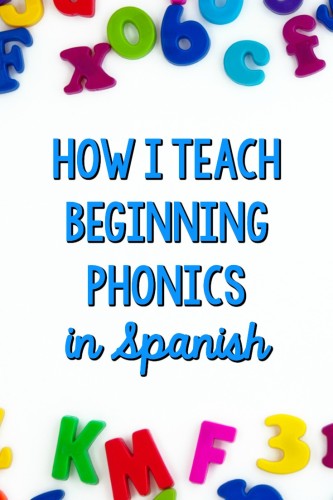
General Phonics Teaching Strategies
When I was a classroom teacher (in the primary grades), my students learned Spanish phonics primarily through a daily minilesson, small group or guided reading work, picture/word sorts, independent centers, and dictados. And, of course, they also learned it through reading and writing activities!
I’ve found it helpful to choose a scope and sequence for the year (click HERE for the Kindergarten scope and sequence I’ve used in the past). Although I differentiate and deviate from it, having a planned-out path helps keep me on track.
To introduce a new letter sound, syllable, or spelling pattern, I typically start with a minilesson. I write the letter or syllable for students, have them read it, and then have them write it in the air. We brainstorm words that contain the letter or syllable.
Next, I introduce a picture sort. I have students cut out and sort pictures into 2 or 3 columns (by beginning sound or syllable, for example), and then write each word underneath. It gives them practice with the letter or syllable in the context of real words. I also encourage students to search for additional words (with the same patterns) in books.
As time goes on, I have students begin to sort words rather than pictures. I also give different students different sorts, based upon their needs. Click HERE for a great book of Spanish word sorts.
During independent work, students continue to practice these same letter sounds, syllables, or spelling patterns. When they’re with me for guided reading or small group literacy instruction, I either reinforce those same phonics patterns or work on other ones (depending upon what students need).
On Fridays, I do a dictado, where I dictate words or a sentence to students. I incorporate some words that have the same sounds and spelling patterns we’ve learned throughout the week. I have students correct their work at the end, and help them make the connection between our phonics work and the words or sentences they’ve written.
I’ve found that it’s important to always relate whatever skill you’re teaching to real reading and writing. Young readers are always so excited when they are able to read or write the type of syllable you’ve been studying in class! This also helps them understand the importance of learning the different phonics skills.
Teaching Letter Sounds
Some bilingual teachers teach the letter sounds in isolation, while others teach them in the context of syllables. Honestly, I don’t think it matters much which way you do it (as long as you move relatively quickly into teaching the syllables, because Spanish is a syllabic language). My personal preference is to teach letter sounds first (without syllables), because I think it gets kids writing and reading emergent texts more quickly.
I always teach the vowel sounds first, because these sounds are the ones that kids can hear and spell most easily. For example, if you asked an emergent reader to write the word “mesa,” you might get something that looks like this: “ea.” It’s easier for students to hear (and spell) vowels as opposed to consonants. AND the vowel letter names and sounds are the same, which makes them easy to remember!
After I teach students the vowels, we move on to the consonants. I like to start with the consonants m, p, s, and l, because these are “easier” consonant sounds for students to hear, say, and spell.
After that, I progress through the rest of the consonants, teaching several per week (when I was in the classroom). Again, you can access the scope and sequence I used when I taught Kinder HERE.
I’ve used the Estrellita program to teach letter sounds for the last 5ish years, and I absolutely love it! There’s a chant and hand movements for each letter, as well as an alphabet chart that goes with it. Students learn the letter sounds so quickly from practicing the chant! You can check out the chant here (it’s not my video – I found it on YouTube!).
Even if you don’t have access to Estrellita, you can still use an alphabet chart and create a chant to go with it. Fill in your information below, and I’ll send you a free Spanish phonological awareness and phonics toolkit that includes an alphabet chart (if you already downloaded the free toolkit from my phonological awareness post, you don’t need to sign up again – you already have the materials):
Success! Check your email right away to download your freebie!
In addition to practicing the alphabet chant once or twice daily, I also like to use picture sorts to give students practice with the letters that we’re currently studying. We practice naming the pictures as a group, and then students work independently to sort the pictures by their initial sounds. After some practice, I also ask them to write each word underneath the picture. I don’t demand correct spelling – it’s just an opportunity for students to practice spelling words by listening for their sounds. There are picture cards in the free Spanish phonics toolkit that you can use to create your own picture sorts. Or, try the book of Spanish word sorts I use (HERE). If you find that some of your students are struggling with letter sounds, try my Spanish Letter Sounds Intervention Pack. It comes with instructions for using the materials for an interactive, engaging interventions. And the printable sheets require no prep!
One other note about teaching letter sounds – I always teach them before teaching letter names. Although I do begin to use the letter names after a couple of months, I’ve found that starting with letter sounds enables kids to begin reading and writing more quickly than does teaching them the letter names.
Teaching Open Syllables (Sílabas Abiertas)
Once students are comfortable with many of the letter sounds, we move on to open syllables with a consonant-vowel pattern, like ma, pe, si, or tu. Something I learned from the Estrellita program is that it can be helpful to teach students multiple syllables with a single vowel, rather than the usual ma me mi mo mu pattern. For example, I teach students ma, pa, sa, and la in one week. Once I’ve taught all the sílabas con a, I move on to sílabas con e. I haven’t read any research about which way is “better” – I think just comes down to personal preference. I always try to help my students connect syllable learning to reading and writing real words. Here are some of the activities I use to students open syllables and words with open syllables:
- Picture sorts – Just like with letter sounds, I use these to give students practice with sorting and writing words that have the syllables we’re studying.
- “Touch and say” blending sheets – Sometimes students struggle with orally blending letters into syllables and syllables into words (i.e. they may read “so….pa” and say “pa” or “sapa” or “sopo” or something completely different from “sopa”). When I see this happening frequently, I give students practice with oral blending – no letters involved. Watch the video below to see how I use the “touch and say” blending sheet to have students practice blending sounds and syllables (this sheet is included in your free phonics download):
- Breaking apart words with magnetic letters – I have students read and make words with open syllables. Having them physically break apart a word into its syllables has been very helpful in getting them to decode simple words!
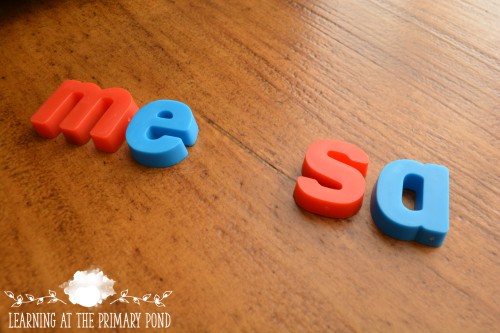
- Escaleras de fluidez – Reading in Spanish requires fast syllable processing. If students take a long time reading syllables, they may need some practice in this area in order to improve their fluency, decoding, and comprehension. My Escaleras de fluidez are a quick and easy way to give students more practice reading syllables. Students practice reading a syllable “ladder” until they are able to read it in a certain amount of time. They progress through different levels, starting with open syllables, then words with 2 open syllables, and on up.

- Escaleras de fluidez – Reading in Spanish requires fast syllable processing. If students take a long time reading syllables, they may need some practice in this area in order to improve their fluency, decoding, and comprehension. My Escaleras de fluidez are a quick and easy way to give students more practice reading syllables. Students practice reading a syllable “ladder” until they are able to read it in a certain amount of time. They progress through different levels, starting with open syllables, then words with 2 open syllables, and on up.
- Building words with open syllables – I have my students engage in different independent activities to give them practice with building and reading words with open syllables. My free phonics toolkit comes with some syllable puzzles that students can use to practice word-building.

- Writing words with open syllables – Writing is sooo good for developing phonological awareness and syllable knowledge in Spanish! My kids love using spelling cards to practice writing words. They can either write the words out or spell them using magnetic letters. The cards progress in difficulty, so you can have students begin with simple words that have 2 open syllables, and then work their way on up. Click HERE for the 2 syllable word cards, and HERE for the 3 syllable word cards.
Teaching Syllables with Blends (Sílabas Trabadas)
Once students have mastered many open syllables, we move on to syllables and words with blends. When I’m getting ready to make the transition from open syllables to syllables with blends, I start having them blend sounds orally. For example, I might say /b/ /r/ /i/, and then the kids say “bri.” I also ask them to think of words that have that syllable (like “brisa”).
I use many of the same activities to teach syllables with blends that I mentioned above (with open syllables). Picture sorts are great, as are breaking apart words with magnetic letters. My Escaleras de fluidez include practice with blends and words with blends:
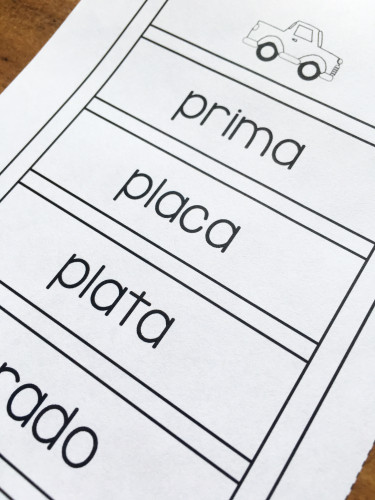
My word cards also include practice with blends (some samples of these are included in the free download, or you can get the complete set HERE.
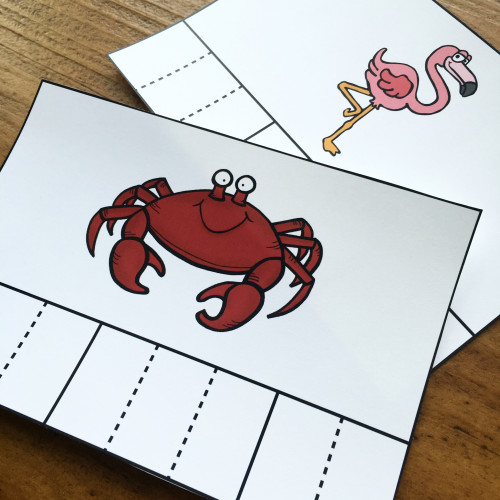
Teaching Closed Syllables (Sílabas Cerradas)
Next, we move on to closed syllables. There are different types of closed syllables, like “im” in “imposible” or “son” in “sonrisa.” These can be tricky when students are used to reading syllables that end in a vowel!
Not to sound like a broken record, but many of the same activities I’ve mentioned work well for teaching closed syllables! Magnetic letters are great for giving students practice with breaking up words and learning that not all syllables have 2 letters.
My Escaleras de fluidez and syllable writing cards give students practice with closed syllables, too. The free Spanish phonological awareness and phonics toolkit (sign up below) contains some sample materials from both of these products.
Success! Check your email right away to download your freebie!
Final Thoughts
Although teaching phonics in Spanish is slightly different from teaching phonics in English, many of the same principles apply. You’ll want to use a defined scope and sequence, provide many opportunities for practice, and always connect phonics learning to real reading and writing.
Do you have any additional activities that you use to teach Spanish phonics? Please comment below – I’d love to hear from you!

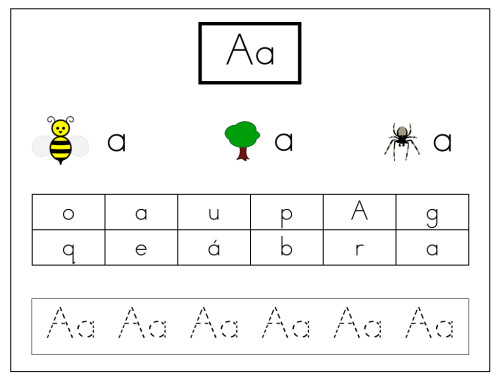
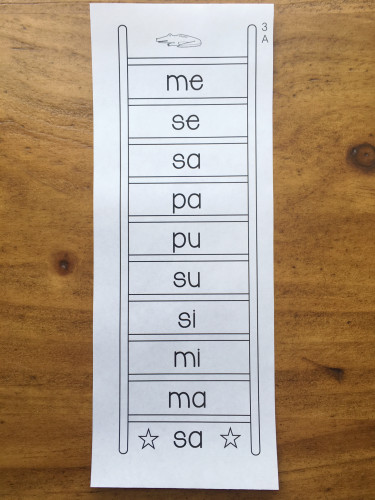
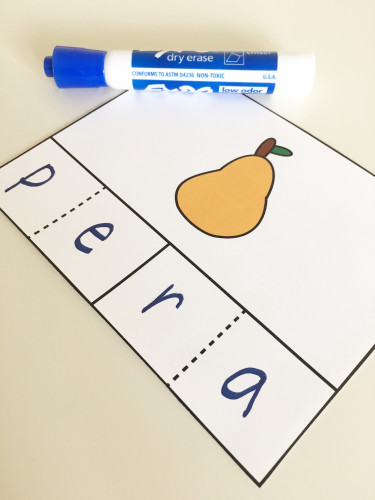
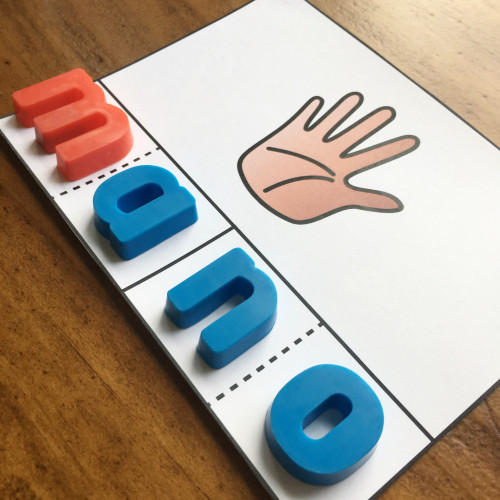
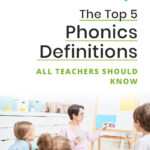
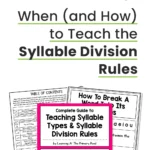









I love all this, I am a first grade bilingual teacher and we teach syllables, but there isn’t really an organization. I am really intrigued to follow your steps.
Hi Sandra! I struggled with the organization piece for a while, too. I hope it works for you! 🙂
Alison
Hi, great post! Is there a 2nd grade scope and sequence? By second, we are at an 80-20 split for our Literacy block and I am trying to understand the phonics when I teach a 2nd grade bilingual class this fall. I have used Words Their Way before and loved it. I am thinking of purchasing the book sorts geared toward Spanish-speaking students but I am struggling at how much ESL I should use because of the proficiency levels of students I will be getting. I plan to continue with Spanish literacy the first few months but then transition into… Read more »
Hi Jess! I think it just depends upon what your school’s model is! I don’t have a 2nd grade scope and sequence unfortunately. When you say 80-20, you mean 80% of the instruction is in Spanish, right?
Alison
I am so glad I found your page. I have been looking for resources to help me with Spanish lang instruction and phonics. Everything I found was for English. This helps so much!! Like one of the comments, I am also teaching a 1st grade bilingual class. You are a life saver! I bought your escaleras de fluidez last year, so it is nice to finally know how you use them! Thank you! I will be checking your blog often.
Oh yay! I’m glad this is helpful! It IS hard to find bilingual/Spanish resources and information. I will try to post more of this soon! 🙂
Alison
Thank you So much for the resource! I will be teaching my first year of kindergarten bilingual and will be using all your strategies, Thanks again!
You’re so welcome! I absolutely love bilingual Kindergarten. Good luck with your first year!
Alison
This is great, do you have anything for smaller kids? Like 3 and 4 year olds?
I don’t; sorry! But I know that the Estrellita beginning sounds program can be used in preschool!
Estrellita.com
Alison
Great resources thanks for taking the time to share, can’t wait to start using them ????
Hi, im glad I found your page. I’m a voluntary a nicaragua and we work a lot with kids with dyslexia. Do you have any tips for teaching 10-12 years old how to read and write? I have heard a lot about a method called phonics instruction – is that what you do here?
Hi there! Working with younger students is more my area of expertise. But I do know that explicit phonics instruction is important with kids of any age who are learning to read – especially for those with dyslexia. Phonics instruction just means that we are teaching kids the sounds that letters make, as well as different word patterns. You may already do quite a bit of that! 🙂
Alison
Thanks so much for this, Alison! I can see so much hard work put into it! I only wish you had all the instruction in Spanish becuase we are a small school in Peru with limited resources and our teachers don’t speak English.
Hi!! Love your post!! Thank you!!! I am curious about closed syllables and syllables with blends, to me it makes more sense teaching closed syllables first—- then finally adding the blends….. any suggestions on that?
Hi Margie! I have known other people to do it that way too. I’m honestly not sure it makes much of a difference – at least the way I teach it, we don’t spend tons and tons of time on the blends before moving onto closed syllables. We do some blends with open syllables so they get the idea, and then we move onto closed syllables afterward since it’s a bit of a different concept than what they’re used to. But I’m sure it works the other way, too! 🙂
Alison
Is the Kindergarten scope and sequence the same for First grade? If not, do you have a first grade scope and sequence. Help!?!
Hey Elizabeth! With first grade, I would start off with a quicker letter review and then do lots of syllables work. 🙂
Alison
Hi Alison, Thank you so much for this information. I will like to know if you have a ¨high frecuency Word¨ list for spanish language, there are so differents list but I need a simple one for used with my daughter with Down Syndr.
Thanks
Hi Marury, I do not – sorry about that!
Alison
Hi there! Does anyone know of professional texts in English or Spanish that provides research and methods for teaching Spanish phonics to young children? I need to do a book study or research and need a good text.
Thank you!
Hi!! Thank you again for all the great advice! I actually just got a compliment this morning from a teacher. She is so impressed on how well her three little ones are coming along these past few weeks because of the morning program (with me :). I took all of the advice on your blog and it actually has made a difference. I have never taught in Spanish (but I do speak Spanish) so I was nervous in the beginning! But your blog and resources have helped me so much!! Thank you!!!
Rosie
I’m so glad, Rosie! That’s truly awesome. Good for you, and thanks so much for sharing this with me!!
Alison
Thanks this is super helpful!
I had one quick follow up question. It seems that Estrellita really focuses on teaching all the consonant sounds with “a” first. I don’t have first hand experience with the program but that’s what I have gathered from what I have read. Do you use that strategy? Does it make that much of a difference in your opinion? Do you teach all syllable vowel combos at a time? Thanks!!
I should have kept reading, your answer was right in your blog. But I do still have a follow up question, you said you would teach ma, pa, sa and la in one week and then move to the other syllables. Does that mean that you would teach the silabas con e, con I, etc before teaching other syllables with a new vowel? Or do you teach the next four consonants with “e”?
Hey Lola! Great question. I do teach all the silabas con a before I start in on the other vocales. So after ma, pa, sa, and la, I go to ra, fa, etc. And finish all those before moving onto the e, and then moving onto the i, etc. Hopefully my Spanglish response here makes sense. 🙂
Alison
Thanks for answering my previous question. Just a quick follow up, do you teach the “rr”? And what about accents? One of the first words I will be teaching my students is Mamá and it has an accent. Thanks again for all your help!
Hi Marianna! I have not been explicitly teaching the “rr” as a letter, no (although we discuss it). And that’s a great question about the accent mark – I very quickly explain what it is and show students the difference between using an accent vs. not using it (a great one is papa vs. papá!). I explain that it’s part of the word and must be used. With older students, I begin teaching it more formally (it sounds like you work with very young ones).
I hope this helps! 🙂
Alison
Hi! I had a question about the sonidos indicales videos. Do you teach all the sounds at once, or do you introduce them by having only the first 3-5 in the beginning and then add more day after day? I’m about to start teaching kindergarten and I’ve never done it before haha
Hey! I introduce just the vowels to start, and then we add on about 4 or so letters each week! 🙂
Alison
Hi Allison:
Do you have a list of the first closed syllables you teach?
Thanks!
Hi Seth, I don’t – sorry about that!
Alison
Hi! I’ve recently discovered your resources and website and I cannot express how ecstatic I am to find another teacher/creator in Spanish!! I’m going on my fourth year teaching 1st grade dual language, and I am loving how I can relate to your method/steps of teaching. Plus I am enjoying all the activity ideas that I am learning from you, especially your scope and sequence for the year. I will definitely be creating one for first grade! Thank you!!
I’m so glad all this is helpful to you!!! Thanks so much for reading and commenting!! 🙂
Alison
Hello Dear Alison, I am an Spanish student who wants to teach Spanish letters to young learners,when I’ve searched something like phonics method for teaching Spanish letters, I’ve just found your suggestion. As a teacher of English phonics, I need a complete source of Spanish Alphabets to teach young learners. So I Need your idea, Do you suggest me any idea or any book or any method for teaching Spanish in the way of phonics?
Please help me….
Hi there! Have you heard of the Estrellita program? I’ve used that in the past and found it very helpful!
Alison
Our school is a dual-immersion Spanish school and we are looking for research about when is the best time to start teaching letter names and sounds in Spanish. Some kinder teachers start in August, and some don’t start with Spanish names and sounds until January, focusing more on the oral language in Spanish and only doing names and sounds in English in the fall. Do you know if there is any research about what is best practice? Thanks.
Hi Erin! I’m not sure I know of any research related specifically to that, but I would check these ladies out if you don’t know them yet! http://www.teachingforbiliteracy.com/
Alison
Hi..I am not a teacher but a Spanish speaking mom wanting to teach my kids Spanish. I have a 7 year old 5 year old and 1 year old. I looked up Estrellita and it’s $800 for pre k that’s a bit pricey for me. ANy recommendations aside from speak to them in Spanish? As clearly I Am failing at that. Any recommendations help. Thank you and thank you for sharing all this information.
Hi! I’m not sure – so sorry about that!
Hello I was unable to subscribe and I was very interested in having access to the free phonological awareness and phonics toolkit
Hi! Did you fill out the little boxes in this post and then check your spam box?
Alison
Thank you for this very helpful blog post. Do you know of any apps for teaching Spanish phonics?
I’m so glad this was helpful! This post has some Spanish apps 🙂 https://learningattheprimarypond.com/blog/spanish-reading-apps/
Hi i am a homeschool parent i wants to teach my daughter in spanish do you know any curriculum to follow that will teach her to read write in spanish ?
Hi Cristina! You could try the Estrellita program. 🙂
Alison
How can I see the chant video?
Hi Maria! The video I used looks like it’s not available anymore, so I would just search for “Estrellita chant” on YouTube to see if one is available.
Alison
Thank you! Do you know of anything in Spanish that is like the BOB books? The early reader book series? Thanks!
Hi Jennifer! I don’t – but I do know there are some decodable books in Reading A to Z (Spanish) and the Estrellita program. 🙂
Alison
these are some great materials! Thank you so much, I found you by chance and I am so glad I did! <3
You’re so welcome!! 🙂
The video for the chant was unavailable.
I use the military alphabet march, as I am a “seasoned” teacher w/ 28 yrs and prefer to teach ALL 30 letters. My 10 – 12 graders LOVE the military alphabet march. I don’t let them hear it until about the 3rd day we’ve completely gone over ALL the letters. (They already know they’ll have a test on them with their chosen Spanish name they have to say and spell.) The rhythm of the march helps them to remember the pronunciations. Plus the students love it!!!
Hi MaryKellie! Yes, I think the video was removed from YouTube (it was not my video).
That march sounds fun!
Why do you call them open syllables? Or closed
Hi Carolina! Good question! It’s called an open syllable because the vowel is “open” meaning that nothing comes after it at the end of the word. A closed syllable refers to a word that is “closed” in by an ending consonant. I hope that helps! 🙂
I like the way you used the dots for each sound per syllable. I will try that as well. Also I had not tried teaching /ma/ /pa/ /sa/ & /la/ in one week.
Thank you, Barbara! I am glad that you find those strategies useful!
This is my first year teaching kindergarten in Spanish. We are following the Victoria book from Guatemala. They start with the usual vowel and then M, S, L, P . And then like you suggested the remaining letters. Does it make a difference what sequence next ? Should it be T, D, N next? We also practice with poems, lotería, syllables flash cards ro take home and practice and songs. Thank you so much . I found you by accident.
Hi, Vera! I’m glad that you were able to find this post useful! 🙂 I have made a scope and sequence that I have used in the past that may give you more guidance on this. Here is the link: https://drive.google.com/file/d/0B1UI0Z21uTN6U0UyM3VHY2pPMkU/view. I would also encourage you to talk to your fellow teachers/administration to see what their preference is as well. I hope this is helpful!
Is it possible that I could have the blending sheet. I wasn’t able to find it. Thank you!
Hi! Did you fill out the little boxes in this post and then check your spam box?
Alison
I LOVE this!!! Do you have resources you recommend for 3-6 graders who are learning Spanish?
Thank you, Jenelle!! Working with younger students is more my area of expertise, but this post may be helpful to you: https://learningattheprimarypond.com/blog/spanish-reading-apps/. It includes some of my favorite apps that are great for students learning to read in Spanish. I hope this helps! 🙂
I would like to purchase all of your resources. Do you have them all together, like a book or large pdf?
Hi Kimberly! So glad to hear you’re interested. Here’s a link to view all of my Spanish materials: TpT Spanish Materials There’s a sale going on today, so if you’d like to buy, today would be a great day to do so!
Love it!! Thank you so much, very helpful!
Thanks, Denisse!
Hello Alison! Thank you so much for your post this is crazy helpful for me. I am a newish bilingual sped teacher and I had no idea how to teach fonetica. Im so grateful. Do you recommend any Phonics assessment in Spanish? Something that has everything that you would want to assess to see where a student is in phonics in Spanish?
Hi Tanya! I’m so sorry to say that we currently do not have an assessment for phonics in Spanish. Maybe I’ll add this to ideas for future products 🙂
I need some activities for my bilingual kindergarten class.
Hey there! Check out my TpT page for many Spanish Kindergarten resources! Here’s the link.
I loved reading your blog about how you taught beginning phonics. I am in a bilingual special education position this year and some of my students are still in the early stages of phonics and reading. Your ideas will really help me get started, however I am having difficulty entering my information for your free phonics toolkit. I am able to enter my name and email but I do not see a button underneath to click. I’ve tried different internet browsers also. Is there another way for you to share it with me. I’m especially interested in your touch and… Read more »
Hi there! Thanks for bringing that to our attention. What’s your email address? I can share the resource with you directly.
mrsmaricruzcody@gmail.com
Thanks!
Thank you! We’ll get that sent over to you. (By the way, the link in the blog should work now! Again, thanks for letting us know!) Link in Blog
Hi, It seems that your K scope and sequence links are dead and I can’t request access either. Thanks!
Hey there! Sorry about that! Try this link: Scope and Sequence
This resource os one of the best I’ve found. Thank you so much for your explicit detail in how you teach phonics. I was wondering where you found your magnetic letters with blue vowels and red consonants?
Hey Michele! I’m sooo happy to hear that! There are a bunch of sites that sell blue/red magnetic letters if you search, but here’s one: Magnetic Letters
Hi! Thank you so much for this resource. I look to your blog a lot to help with my Spanish instruction. I have a question about decoding strategies to teach during shared reading and guided reading groups. Would you ever teach students to decode using isolated sounds? For example, if students are still building vocabulary, but know most letter sounds, however, I am following Estrellitas phonics program and haven’t reach syllables yet, should I teach students to isolate sounds in a word. If we are reading “mama” should I teach students to sounds out each sound? /m/ /a/ /m/ /a/?… Read more »
Hey Patricia! I think you can definitely model how to break up a word into syllables before reaching it in the scope, but just know that students will need tons and tons of practice with this concept! Here’s a blog I wrote about syllables and I go through when to teach each rule: https://learningattheprimarypond.com/blog/how-to-teach-syllable-division-rules/